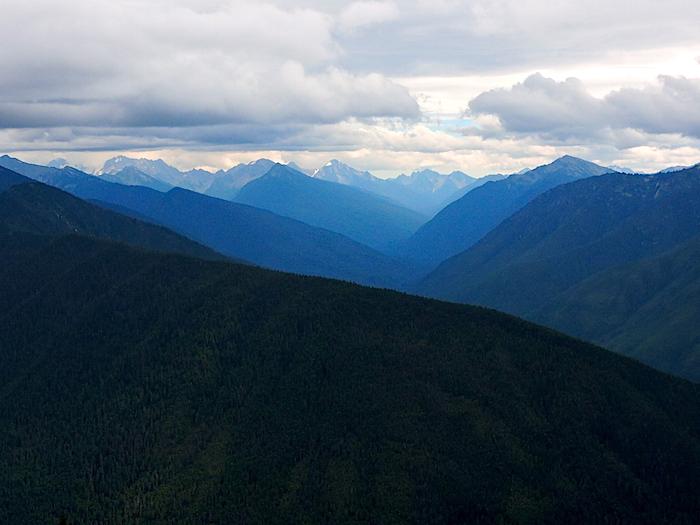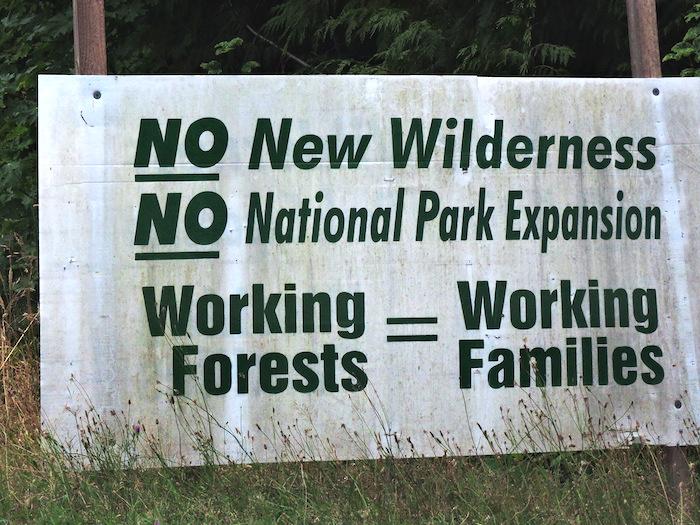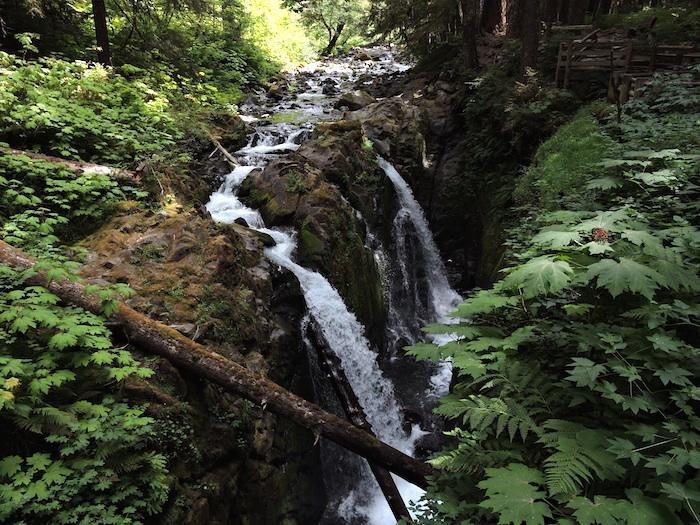
In 1890, surveyor Lt. Joseph P. O’Niel wrote, “While the outer slope of these mountains is valuable, the interior is useless for all practical purposes. It would, however, serve admirably for a national park.”/Lee Dalton
Along the Elwha River
I met a charming lady while standing atop what’s left of Glines Canyon Dam – a dam recently removed from Elwha River in Olympic National Park. Sharon Francis and her son were there with a girl who I guess is probably her granddaughter. I offered to take a photo of all three of them together, and that led to the discovery that I was talking to the woman who had been Stewart Udall’s speechwriter.
She said she had been following the dam’s removal online and was happy to have a chance to see it in person. I made a crack about the need to remove more dams around the country and that’s when she told me she had been present at the dedication of the Glen Canyon Dam that holds back the Colorado River in Arizona and Utah.
She had written speeches given that day by both Secretary of Interior Udall and First Ladybird Johnson. She had been involved in helping Secretary Udall and legendary Arches Superintendent Bates Wilson prepare for many of the wranglings that finally led to creation of Canyonlands National Park. She’d had a front-row seat to many other historic events in those dynamic days of environmental progress. Our talk ranged across a wide field of subject matter as we filled each other in on current affairs and political disasters within and without the National Park Service.
As usual, I failed to think fast enough to seize a great opportunity. I didn’t ask for her contact information. That seems a bit intrusive to me. But I did tell her to check Traveler’s website. Now I hope that when she does, we might convince her to contribute some articles. I’m sure she has a treasure trove of tales that could really add interesting substance to the site.
I hope she will.
Meanwhile, the Elwha River is slowly recovering from its long drowning and salmon are actually beginning to return.
The Elwha area isn’t particularly scenic and doesn’t contain anything really special. But I used Elwha Campground as my base of operations for a few days while I explored the northern part of this huge park.
Olympic is a fine example of what I think an NPS natural area should be. Large, large wilderness that is crossed only by trails. No highways or even dirt tracks. Ninety percent is designated as wilderness. Hiking trails galore and long expanses of almost nothing created by the Hand of Man. Highways circle the park, and in a few places roads slice into the interior along narrow corridors to reach places like Elwha, Hurricane Ridge, the Quinault and Hoh rain forests, some trailheads, and a few other special places. But aside from those, this park remains much as it always has been.
Some of that is due to early attempts to set parts of it aside. It was so rugged that there was virtually no exploration until much of the surrounding area was well settled. It was too rugged to log with technology of the time. An interesting quote is found on a display in the visitor center at Hurricane Ridge. In 1890, surveyor Lt. Joseph P. O’Niel wrote, “While the outer slope of these mountains is valuable, the interior is useless for all practical purposes. It would, however, serve admirably for a national park.”
It does. Thank goodness for our worthless national parks.
But the battles, of course, continue to rage on. Along the roads leading to Elwha are various signs opposing addition of wilderness or expansion of the park. Not far from Elwha Campground are some signs tacked to trees trying to block the opening of a proposed gravel and rock mine just outside the park. Those signs apparently posted by people who live in a few scattered homes up there.
I guess it just goes to prove that as long as there is more than one person around, there will be conflicts. Yet, I’m not sure even that’s really true given all the times I find myself arguing with myself – and losing. Maybe it’s true that this world would be a much better place without all those people in it.
But we seem to be stuck with us, so might as well try to make the best of it. And where better to start than in a huge and wild national park like Olympic?

Opposition continues to designated wilderness and expansion at Olympic National Park/Lee Dalton
A Great Basecamp
Elwha is located in an ideal spot for exploring Olympic’s north side. Just a short drive from grocery stores and gas stations in Port Angeles and not far from the road leading to Hurricane Ridge and the park’s main visitor center.
Although Hurricane Ridge is a central feature of the park, it was never really crowded either of the times I was up there. The view is spectacular, even when stormy clouds blanket the mountains as they did on my first trip. The visitor center is the nucleus for a number of short interpretive and hiking trails. It was good to see a lot of families exploring them.
Mostly, though, Hurricane Ridge seems to be pretty much a look and see and then move on stop for most. There are some ranger interpretive programs offered a couple of times each day, but the one I watched was very sparsely attended.
Not too far west of Elwha, Highway 101 takes you to Lake Crescent. A beautiful blue lake, but the north side appears to be filled with homes. Inholdings, perhaps? There’s a lodge and ranger station along the south shore, but I didn’t stop there. A little farther west, you’ll reach the turnoff that leads to Sol Duc and Sol Duc Hot Springs Resort. That’s pronounced Soul Duck, by the way. Some short interpretive trails here are well worth investigating. When I wandered through Ancient Groves, I had the place to myself. Walking among those majestic ancient old growth trees was like visiting a quiet shrine. There’s some kind of special spell in a place like that.
But special though it may be, it appeared to be a special place under stress. Dry. Mercy, it was dry! Moss that I’m sure must usually be soft and green was dull and crunchy in mid-August. Step off the trail and your steps sounded like walking on cornflakes. Fuel loading in that forest is very, very high. All it would take would be one match. One carelessly tossed cigarette butt and the Ancient Grove could be history.
On the south side of the park, a stubborn fire had been burning since May.
A few miles farther, at the end of the road, is the trailhead to Sol Duc Falls and the park’s interior. The parking lot was crowded and many had groups of people either taking off or donning backpacks. Hiking out to the falls, I found myself stepping off the trail fairly frequently to allow someone with a loaded backpack to pass more easily.
It’s an easy hike to the falls. To my eye, unfamiliar with what might be normal, the falls looked like they were flowing nicely. But some other folks around me were remarking that they were just a fraction of what they usually are. Summer’s dryness seemed to be on the minds of nearly everyone. It was, they said, the hottest and driest summer the rainforests had experienced in all 141 years weather records have been kept.
A highlight of Sol Duc was a stop at the resort where I spent a soothing hour soaking in the hot spring pool. Ahhhhhh!

Sol Duc Falls was said by some to be just a trickle of its normal self in August/Lee Dalton
Back at Elwha camp, another camper and I witnessed a disturbing case of an abusive adult bullying and thumping on a couple of little boys. When the “lady” saw us watching, she turned her abuse on us. We asked the camp hosts to call for law enforcement. It took nearly two hours, but two law enforcement rangers finally showed up and handled an ugly situation very well.
It was during this waiting time that the hosts filled me in on a few facts of life at Elwha. Park staffing, they said, is at a bare minimum. Law enforcement rangers who cover Elwha also handle calls to Sol Duc, Lake Crescent, accidents on Highway 101, and must even patrol Hurricane Ridge. A span of at least 70 miles.
“They’re just exhausted,” one of the hosts said.
Elwha, being close to a large city like Port Angeles, is one of those party central spots for young local folks. The hosts recounted some potentially nasty situations they’d had to try to handle during long waits for rangers to arrive.
Not good. Not good at all.
I took one day and drove out along the south shore of Juan de Fuca Strait on state highway 112 to Cape Flattery. This is the northwestern most point of land in the Lower Forty-Eight. It’s located on Makah tribal land and there’s a $10 recreation fee. But now I can say that I’ve been to both the most northeasterly and northwesterly points in the lower continental portion of our homeland.
All along the way, in every small town I passed and especially in Neah Bay, signs warned of severe water restrictions. In Neah Bay, the convenience store’s soda machine was shut down with a sign that read, “No Water No Soda Canned Pop Only.” I asked and learned that towns up here have no wells. Usually no need for them. Water comes from rivers, is treated, and then is stored in fairly small reservoir tanks.
“We can’t keep the tank full. River’s too low,” a clerk told me.
Finally, at 0600 on a Sunday morning, my last day in Elwha, there came one of those moments that makes your heart skip a beat or two. I was lying lazy in my bunk enjoying a quiet, windless time when I heard branches breaking. Then large trees snapping off. Something HUGE was coming down somewhere. The question immediately became, where is whatever it is going to land? Then came the BIG THUMP that l swear lifted my little trailer an inch or two off the ground. Not a rockfall, but the roots of a huge Douglas fir about five feet in diameter and a couple of hundred feet tall had failed at the south end of the camp. It missed some walk-in campsites by just a few feet. No one was hurt, but I’m sure a few tent campers needed some extra coffee that morning.
I don’t drink coffee, so I had some extra orange juice and then broke camp to head for Kalaloch where I had a reservation for a week in what has to be one of the greatest places in all 407 of our national parks (or whatever the number happens to be today).
And so, dear readers, if you all promise to be good little boys and girls and send a generous donation to keep Traveler up and running, I’ll tell you all about Kalaloch and other points west in yet another Musing from Olympic.



Comments
Lee... I'm enjoying - with no small amount of envy - your walkabout musings from various parks.
Thanks Lee,
I hiked the Elwha, from the snowfinger to the ocean during a Bailey Traverse before removal of the damns... might be time to do it again, experience the rivers changes.
Your articles are always enjoyable to read, Lee. I was there eons ago before my move to Texas (which I still consider a temporary move). Younger then, I didn't notice half as much as I would now (I hope). This article reminds me to go there again.